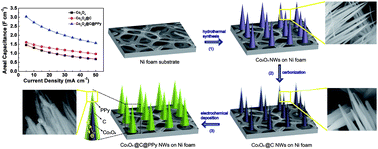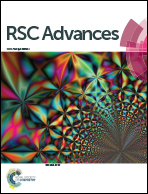The construction of a sandwich structured Co3O4@C@PPy electrode for improving pseudocapacitive storage†
Abstract
Sandwich structured hybrids consisting of a Co3O4 nanowire as the core, amorphous carbon (C) as the inner shell and a polypyrrole (PPy) outer layer as the exodermis are synthesized via a hydrothermal method and constant current electropolymerization. The formation mechanism and growth stage of PPy on carbon surfaces is investigated and it was discovered that PPy layer thickness, corresponding to nucleation time of the polymer, as the dynamic factor, can influence the pseudocapacitive properties of the obtained composites. The carbon layer acts as both a network to increase the electric conductivity and a buffer agent to reduce volume expansion of Co3O4 during ion insertion/extraction to achieve higher capacitance and better cyclic stability. So for a capacitor, the Co3O4@C@PPy electrode delivers a higher areal capacitance of 2.71 F cm−2 at 10 mA cm−2 (1663 F g−1 at 6.1 A g−1) and improved rate capability compared to Co3O4 and Co3O4@C. An asymmetric device is assembled by the Co3O4@C@PPy hybrids as a cathode and a relatively high energy density of 63.64 W h kg−1 at a power density of 0.54 kW kg−1 is obtained, demonstrating that the sandwich structured Co3O4@C@PPy hybrids have enormous potential for high-performance pseudocapacitors.



 Please wait while we load your content...
Please wait while we load your content...